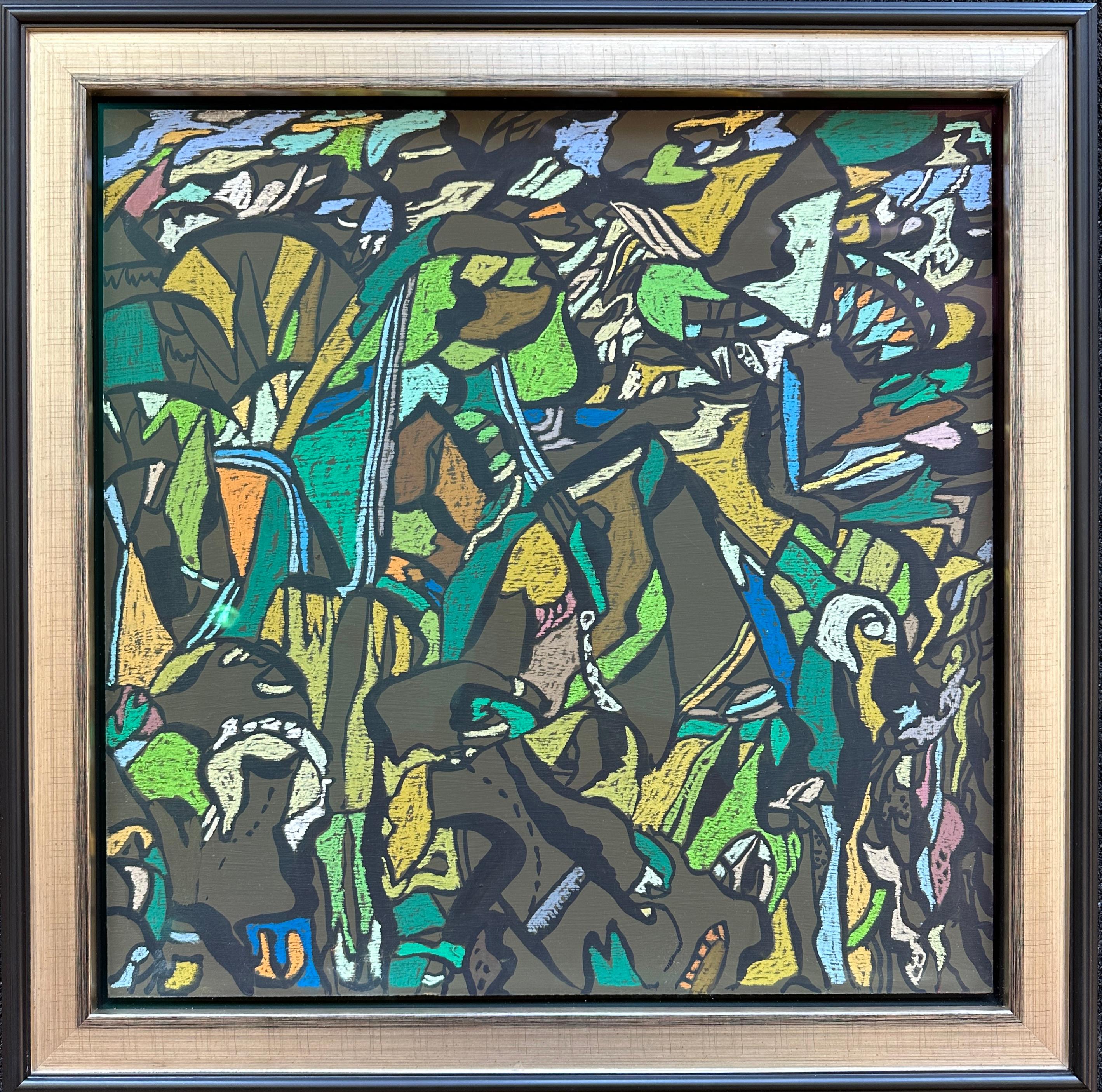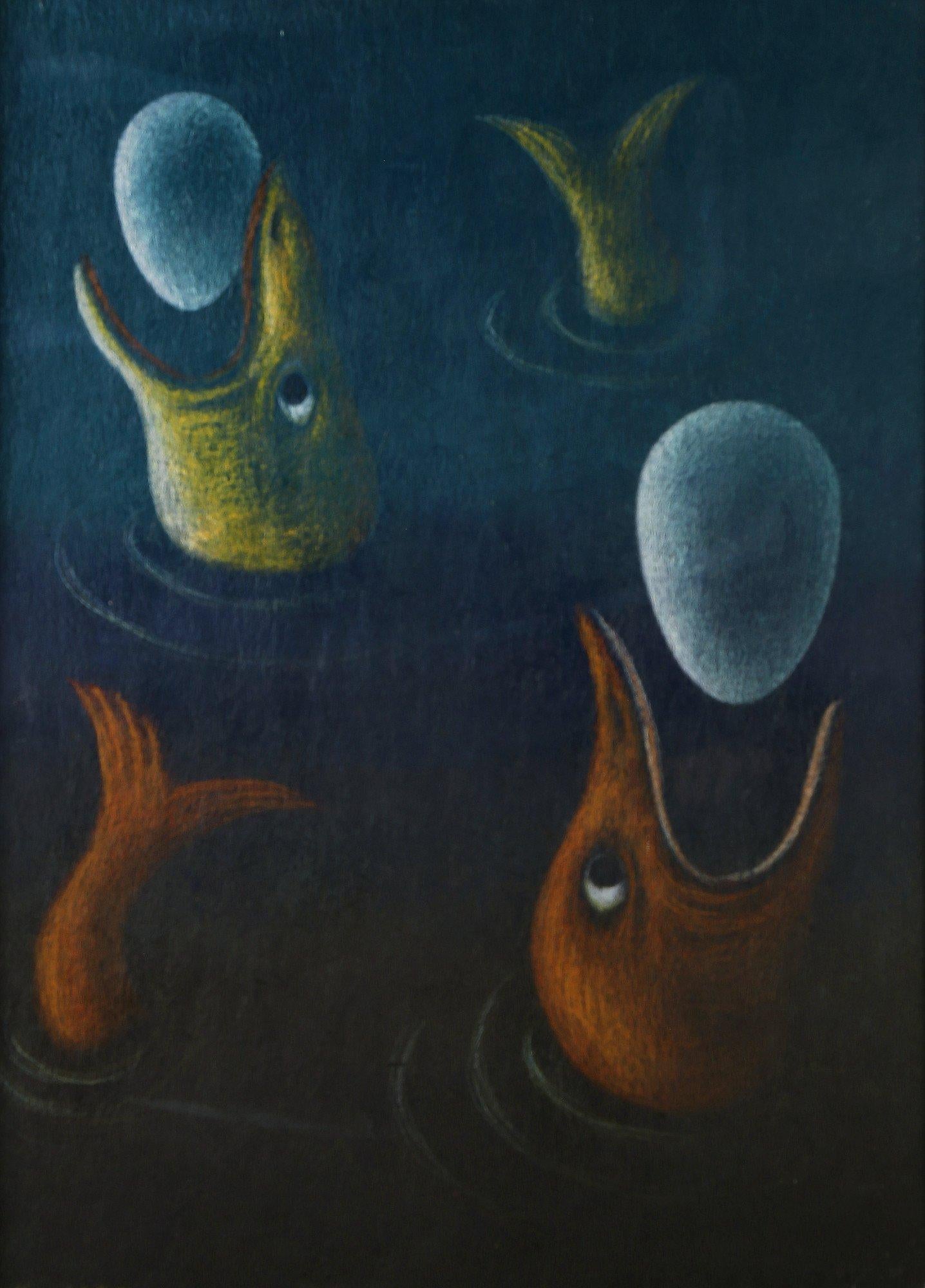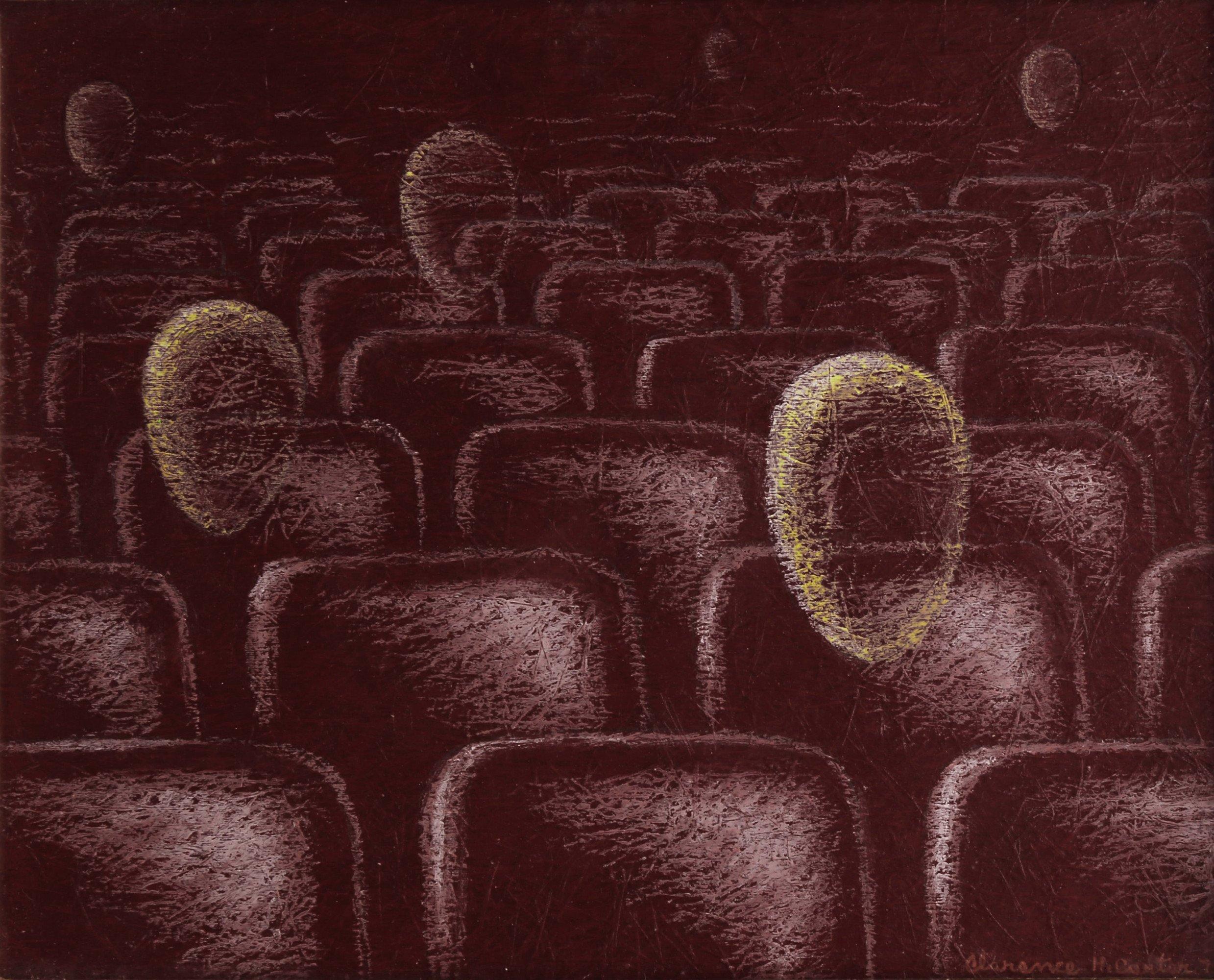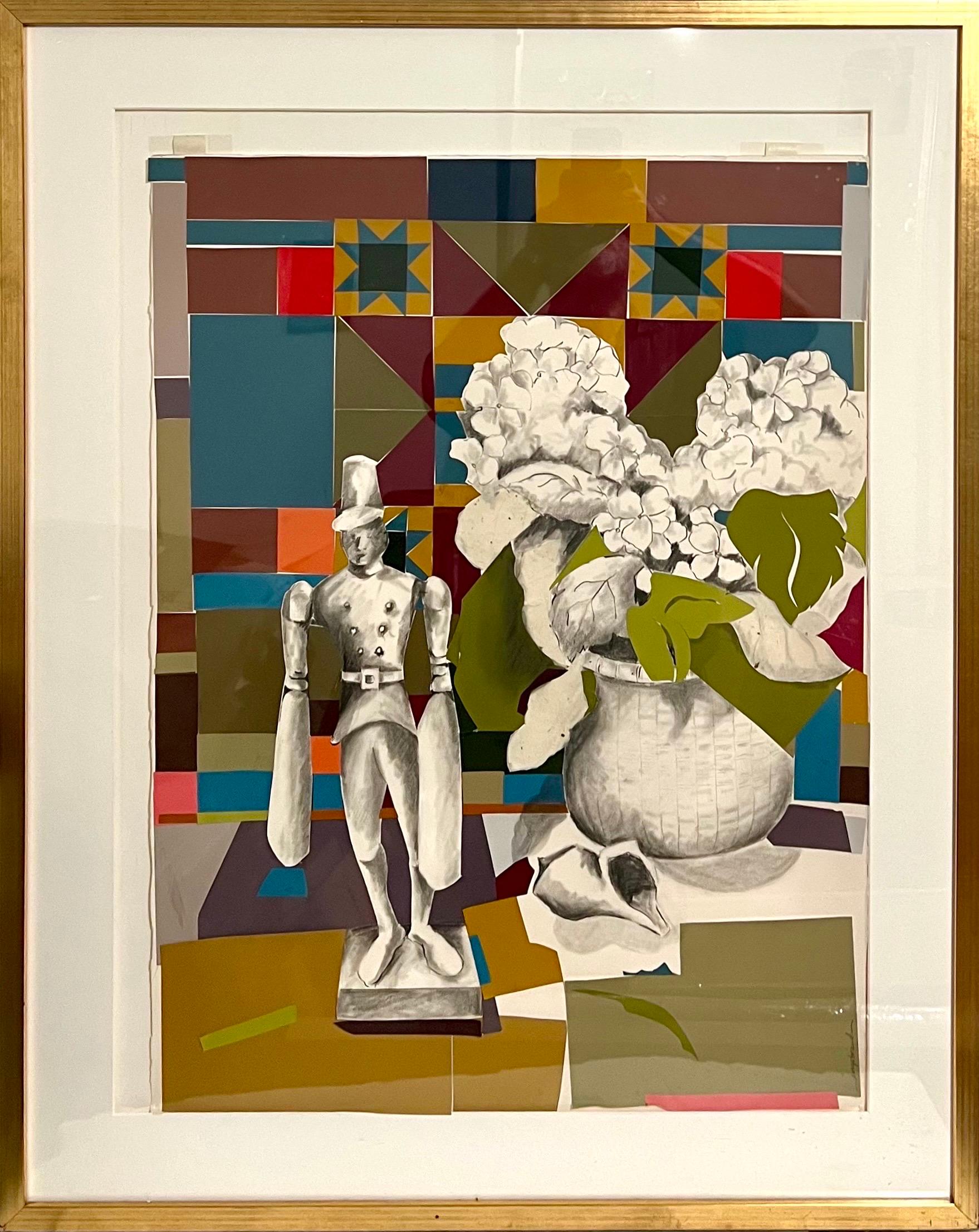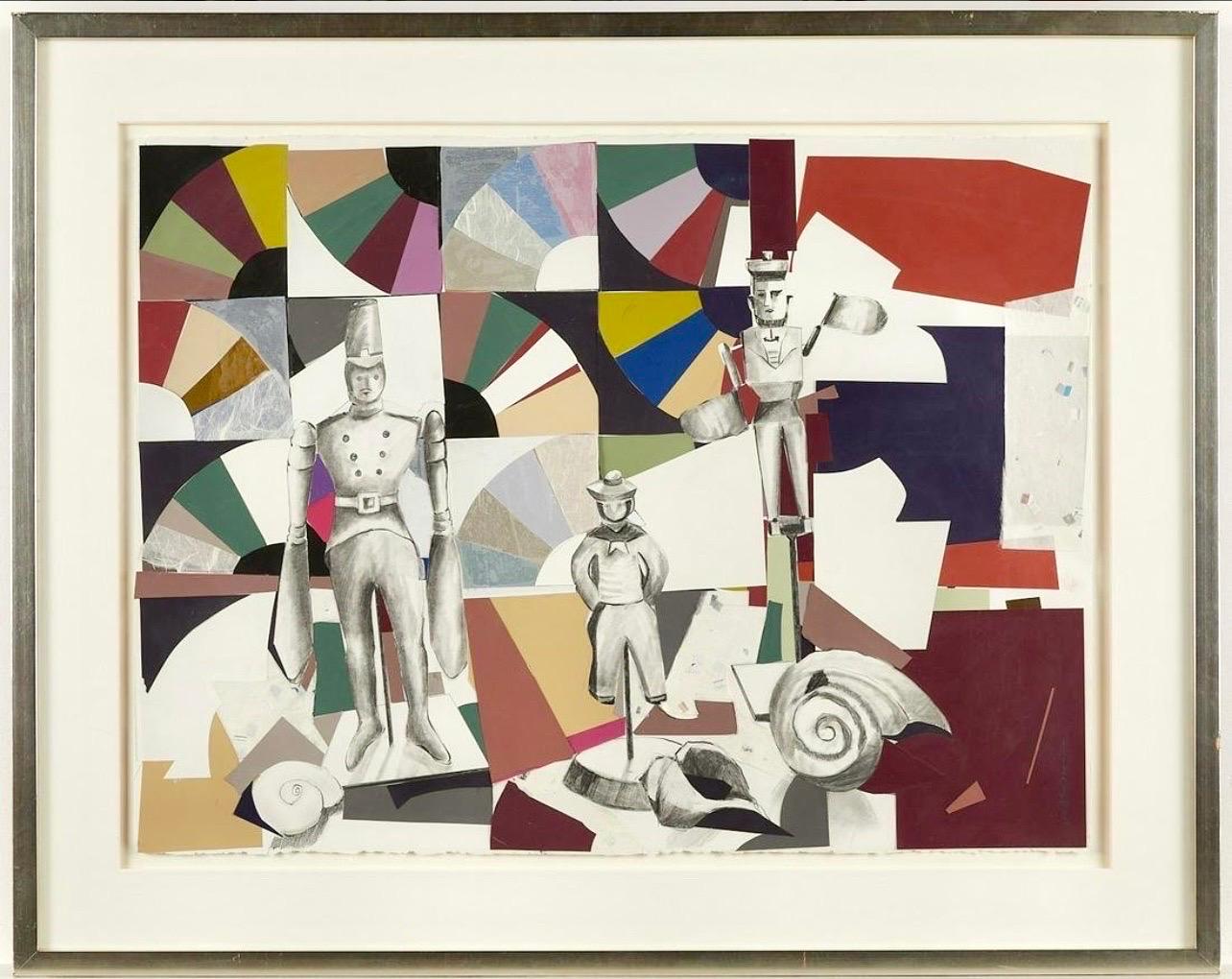Items Similar to Over Isfahan by Fred Martin
Want more images or videos?
Request additional images or videos from the seller
1 of 11
Fred MartinOver Isfahan by Fred Martin1971
1971
About the Item
In the summer of 1970, I had been using acrylic for four years and had yet to find a way to develop color like a composer might orchestrate a symphony from a piano score. (The symphonic was then my visual ideal.) After the 106th acrylic of “majestic” size, I got real about scale—smaller—and switched to colored sticks of soft pastel so I could hold a rainbow in my hand. I kept on with the streaming lines of the big acrylic paintings, but I filled the spaces between with the soft pastels. –Fred Martin
Exhibited:
2003 Oakland Museum of California "Fred Martin Retrospective"
A native Californian, Fred Martin was born in San Francisco in 1927, and received both his BA (1949) and MA (1954) from University of California, Berkley. At the San Francisco Art Institute Martin studied with Clyfford Still, Mark Rothko and David Park. After receiving his masters degree Martin became the Director of Exhibitions at the SFAI, and thus began a life-long relationship with the Institute. He held multiple positions including Director of the College at the San Francisco Art Institute until 1975, and from 1983-92 Dean of Academic Affairs.
Martin's works were influenced by his varied and wide-ranging interests. According to one of his students, "[He] is a pure believer in the importance of art as a spiritual activity." Many of Martin's paintings may be found in museums including MoMA, the Whitney, Los Angeles County Museum of Art, San Francisco Museum of Modern Art, as well as other museums and private collections.
The framed dimensions are 22" x 22" x 1.75" This work is signed and titled verso.
- Creator:Fred Martin (1927, American)
- Creation Year:1971
- Dimensions:Height: 18 in (45.72 cm)Width: 18 in (45.72 cm)
- Medium:
- Movement & Style:
- Period:
- Condition:
- Gallery Location:Hudson, NY
- Reference Number:
About the Seller
5.0
Vetted Seller
These experienced sellers undergo a comprehensive evaluation by our team of in-house experts.
Established in 1973
1stDibs seller since 2023
5 sales on 1stDibs
Typical response time: <1 hour
- ShippingRetrieving quote...Ships From: Hudson, NY
- Return PolicyThis item cannot be returned.
More From This SellerView All
- Untitled 006 abstract painting by Fred MartinBy Fred MartinLocated in Hudson, NYExhibited: 2003 Oakland Museum of California "Fred Martin Retrospective" A native Californian, Fred Martin was born in San Francisco in 1927, and received both his BA (1949) and MA (1954) from University of California, Berkley. At the San Francisco Art Institute Martin studied with Clyfford Still, Mark Rothko and David Park...Category
1970s American Modern Abstract Paintings
MaterialsMasonite, Pastel, Acrylic
- Spring Landscape acrylic and pastel painting by Fred MartinBy Fred MartinLocated in Hudson, NYExhibited: 1973 San Francisco Museum of Art 2003 Oakland Museum of California "Fred Martin Retrospective" A native Californian, Fred Martin was born...Category
1970s American Modern Abstract Paintings
MaterialsMasonite, Pastel, Acrylic
- The Magician oil and tempera painting by Julio de DiegoBy Julio de DiegoLocated in Hudson, NYJulio De Diego’s Atomic Series paintings made an extraordinary statement regarding the shock and fear that accompanied the dawn of the nuclear age. In the artist’s own words, “Scientists were working secretly to develop formidable powers taken from the mysterious depths of the earth - with the power to make the earth useless! Then, the EXPLOSION! . . . we entered the Atomic Age, and from there the neo-Atomic war begins. Explosions fell everywhere and man kept on fighting, discovering he could fight without flesh.” To execute these works, De Diego developed a technique of using tempera underpainting before applying layer upon layer of pigmented oil glazes. The result is paintings with surfaces which were described as “bonelike” in quality. The forms seem to float freely, creating a three-dimensional visual effect. In the 1954 book The Modern Renaissance in American Art, author Ralph Pearson summarizes the series as “a fantastic interpretation of a weighty theme. Perhaps it is well to let fantasy and irony appear to lighten the devastating impact. By inverse action, they may in fact increase its weight.” Exhibited 1964 Marion Koogler McNay Art Institute, San Antonio, Texas This work retains its original frame which measures 54" x 42" x 2" About this artist: Julio De Diego crafted a formidable persona within the artistic developments and political struggles of his time. The artist characterized his own work as “lyrical,” explaining, “through the years, the surrealists, the social-conscious painters and the others tried to adopt me, but I went my own way, good, bad or indifferent.” [1] His independence manifested early in life when de Diego left his parent’s home in Madrid, Spain, in adolescence following his father’s attempts to curtail his artistic aspirations. At the age of fifteen he held his first exhibition, set up within a gambling casino. He managed to acquire an apprenticeship in a studio producing scenery for Madrid’s operas, but moved from behind the curtains to the stage, trying his hand at acting and performing as an extra in the Ballet Russes’ Petrouchka with Nijinsky. He spent several years in the Spanish army, including a six-month stretch in the Rif War of 1920 in Northern Africa. His artistic career pushed ahead as he set off for Paris and became familiar with modernism’s forays into abstraction, surrealism, and cubism. The artist arrived in the U.S. in 1924 and settled in Chicago two years later. He established himself with a commission for the decoration of two chapels in St. Gregory’s Church. He also worked in fashion illustration, designed magazine covers and developed a popular laundry bag for the Hotel Sherman. De Diego began exhibiting through the Art Institute of Chicago in 1929, and participated in the annual Chicago Artists Exhibitions, Annual American Exhibitions, and International Water Color Exhibitions. He held a solo exhibition at the Art Institute of Chicago in the summer of 1935. Though the artist’s career was advancing, his family life had deteriorated. In 1932 his first marriage dissolved, and the couple’s young daughter Kiriki was sent to live with friend Paul Hoffman. De Diego continued to develop his artistic vocabulary with a growing interest in Mexican art. He traveled throughout the country acquainting himself with the works of muralists such as Carlos Merida, and also began a collection of small native artifacts...Category
1940s American Modern Abstract Paintings
MaterialsMasonite, Oil, Tempera
- St. Atomic oil and tempera painting by Julio de DiegoBy Julio de DiegoLocated in Hudson, NYJulio De Diego’s Atomic Series paintings made an extraordinary statement regarding the shock and fear that accompanied the dawn of the nuclear age. In the artist’s own words, “Scientists were working secretly to develop formidable powers taken from the mysterious depths of the earth - with the power to make the earth useless! Then, the EXPLOSION! . . . we entered the Atomic Age, and from there the neo-Atomic war begins. Explosions fell everywhere and man kept on fighting, discovering he could fight without flesh.” To execute these works, De Diego developed a technique of using tempera underpainting before applying layer upon layer of pigmented oil glazes. The result is paintings with surfaces which were described as “bonelike” in quality. The forms seem to float freely, creating a three-dimensional visual effect. In the 1954 book The Modern Renaissance in American Art, author Ralph Pearson summarizes the series as “a fantastic interpretation of a weighty theme. Perhaps it is well to let fantasy and irony appear to lighten the devastating impact. By inverse action, they may in fact increase its weight.” Exhibited 1950 University of Illinois at Urbana "Contemporary American Painting" 1964 Marion Koogler McNay Art Institute, San Antonio, Texas This work retains its original frame which measures 54" x 36" x 2". About this artist: Julio De Diego crafted a formidable persona within the artistic developments and political struggles of his time. The artist characterized his own work as “lyrical,” explaining, “through the years, the surrealists, the social-conscious painters and the others tried to adopt me, but I went my own way, good, bad or indifferent.” [1] His independence manifested early in life when de Diego left his parent’s home in Madrid, Spain, in adolescence following his father’s attempts to curtail his artistic aspirations. At the age of fifteen he held his first exhibition, set up within a gambling casino. He managed to acquire an apprenticeship in a studio producing scenery for Madrid’s operas, but moved from behind the curtains to the stage, trying his hand at acting and performing as an extra in the Ballet Russes’ Petrouchka with Nijinsky. He spent several years in the Spanish army, including a six-month stretch in the Rif War of 1920 in Northern Africa. His artistic career pushed ahead as he set off for Paris and became familiar with modernism’s forays into abstraction, surrealism, and cubism. The artist arrived in the U.S. in 1924 and settled in Chicago two years later. He established himself with a commission for the decoration of two chapels in St. Gregory’s Church. He also worked in fashion illustration, designed magazine covers and developed a popular laundry bag for the Hotel Sherman. De Diego began exhibiting through the Art Institute of Chicago in 1929, and participated in the annual Chicago Artists Exhibitions, Annual American Exhibitions, and International Water Color Exhibitions. He held a solo exhibition at the Art Institute of Chicago in the summer of 1935. Though the artist’s career was advancing, his family life had deteriorated. In 1932 his first marriage dissolved, and the couple’s young daughter Kiriki was sent to live with friend Paul Hoffman. De Diego continued to develop his artistic vocabulary with a growing interest in Mexican art. He traveled throughout the country acquainting himself with the works of muralists such as Carlos Merida, and also began a collection of small native artifacts...Category
1940s American Modern Abstract Paintings
MaterialsMasonite, Oil, Tempera
- Inevitable Day – Birth of the Atom oil and tempera painting by Julio De DiegoBy Julio de DiegoLocated in Hudson, NYJulio De Diego’s Atomic Series paintings made an extraordinary statement regarding the shock and fear that accompanied the dawn of the nuclear age. In the artist’s own words, “Scientists were working secretly to develop formidable powers taken from the mysterious depths of the earth - with the power to make the earth useless! Then, the EXPLOSION! . . . we entered the Atomic Age, and from there the neo-Atomic war begins. Explosions fell everywhere and man kept on fighting, discovering he could fight without flesh.” To execute these works, De Diego developed a technique of using tempera underpainting before applying layer upon layer of pigmented oil glazes. The result is paintings with surfaces which were described as “bonelike” in quality. The forms seem to float freely, creating a three-dimensional visual effect. In the 1954 book The Modern Renaissance in American Art, author Ralph Pearson summarizes the series as “a fantastic interpretation of a weighty theme. Perhaps it is well to let fantasy and irony appear to lighten the devastating impact. By inverse action, they may in fact increase its weight.” Bibliography Art in America, April 1951, p.78 About this artists: Julio De Diego crafted a formidable persona within the artistic developments and political struggles of his time. The artist characterized his own work as “lyrical,” explaining, “through the years, the surrealists, the social-conscious painters and the others tried to adopt me, but I went my own way, good, bad or indifferent.” [1] His independence manifested early in life when de Diego left his parent’s home in Madrid, Spain, in adolescence following his father’s attempts to curtail his artistic aspirations. At the age of fifteen he held his first exhibition, set up within a gambling casino. He managed to acquire an apprenticeship in a studio producing scenery for Madrid’s operas, but moved from behind the curtains to the stage, trying his hand at acting and performing as an extra in the Ballet Russes’ Petrouchka with Nijinsky. He spent several years in the Spanish army, including a six-month stretch in the Rif War of 1920 in Northern Africa. His artistic career pushed ahead as he set off for Paris and became familiar with modernism’s forays into abstraction, surrealism, and cubism. The artist arrived in the U.S. in 1924 and settled in Chicago two years later. He established himself with a commission for the decoration of two chapels in St. Gregory’s Church. He also worked in fashion illustration, designed magazine covers and developed a popular laundry bag for the Hotel Sherman. De Diego began exhibiting through the Art Institute of Chicago in 1929, and participated in the annual Chicago Artists Exhibitions, Annual American Exhibitions, and International Water Color Exhibitions. He held a solo exhibition at the Art Institute of Chicago in the summer of 1935. Though the artist’s career was advancing, his family life had deteriorated. In 1932 his first marriage dissolved, and the couple’s young daughter Kiriki was sent to live with friend Paul Hoffman. De Diego continued to develop his artistic vocabulary with a growing interest in Mexican art. He traveled throughout the country acquainting himself with the works of muralists such as Carlos Merida, and also began a collection of small native artifacts...Category
1940s American Modern Abstract Paintings
MaterialsMasonite, Oil, Tempera
- Ceremonial Dancers oil and tempera painting by Julio De DiegoBy Julio de DiegoLocated in Hudson, NYArtwork measures 48" x 30" and framed 56 ¼" x 38 ¼" x 3" Provenance: John Heller Gallery, NYC, circa 1975 (label verso) The artist's daughter Corbino Galleries, Sarasota, FL (1990)...Category
1940s Modern Abstract Paintings
MaterialsMasonite, Oil, Tempera
You May Also Like
- Chimeras, mid-century figural abstract blue acrylic paintingBy Clarence Holbrook CarterLocated in Beachwood, OHChimeras, 1974 Acrylic and pastel on textured paper Mid-century figural abstract blue acrylic painting Clarence Holbrook Carter achieved a level of national artistic success that w...Category
1970s American Modern Figurative Paintings
MaterialsPastel, Acrylic
- Entr'acte - Mid-Century Ovoids in Theatre - Geometrical Abstract PastelBy Clarence Holbrook CarterLocated in Beachwood, OHClarence Holbrook Carter (American, 1904-2000) Entr'acte, 1977 Pastel on board Signed and dated lower right 8 x 10 inches A surrealist mid-century figural abstract painting. Clare...Category
1970s American Modern Abstract Paintings
MaterialsPastel
- Mixed Media Modernist Painting Collage Nantucket Whirligig Americana Folk ArtBy Mary Ingebrand-PohladLocated in Surfside, FLMary Ingebrand-Pohlad (American, b. 1953). Graphite, pastel, and paper collage painting "Nantucket Still Life with Whirligig and Hydrangea" depicting a mixed media still life colla...Category
1990s American Modern Mixed Media
MaterialsPaper, Pastel, Graphite
- Mixed Media Modernist Painting Collage Nantucket Whirligig Americana Folk ArtBy Mary Ingebrand-PohladLocated in Surfside, FLMary Ingebrand-Pohlad (American, b. 1953). Graphite, pastel, and paper collage painting "Still Life with Quilt and Nantucket Whirligig" depicting a mixed media still life collage ...Category
1990s American Modern Mixed Media
MaterialsPaper, Pastel, Graphite
- "Animal" Abstract Oil on Canvas Award Winning Illustrator Bill ShieldsLocated in Arp, TXBill Shields "Pink Abstract" 1970's Oil on canvas Artist's wood frame 30"x2"x24" Signed in paint lower right Excellent Condition - Minor wear consistent with age and history. CV EDUCATION: Chicago Academy Of Fine Art San Antonio Art Institute MAJOR FIELDS OF PROFESSIONAL ENDEAVOR: Freelance graphic design and illustration Instructor of painting and illustration Landscape, figurative and abstract painting ART RELATED EMPLOYMENT: (Professor of Art) California College of Arts and Crafts, Oakland, CA Academy of Art College, San Francisco, CA San Francisco Art Institute San Jose State University AWARDS FOR ILLUSTRATION, Gold Medals: New York Society of Illustrators Los Angeles Society of Illustrators San Francisco Society of Illustrators Dallas-Fort Worth Art Director's Club Houston Artist's Guild BIBLIOGRAPHY: Feature articles in: American Artist, Communication Arts, Print, North Light. Architectural design featured in: Better Homes and Gardens, American Home, Sunset Magazine, Architectural Digest. ILLUSTRATION CLIENTS: Oil Companies: Champlin Oil Company, Mobil Oil Company, Continental Oil Company, Standard Oil Company, Humble Oil and Refining Company. Industrial: Hughes Tool Company, General Electric, United States Steel, Phelps Dodge, Sylvania Television, Texas Gulf Sulphur, Litton Industries, Houston Lighting and Power Company, International Business Machines. Institutional: National Aeronautics and Space Administration, United States Air Force, United States Department of the Interior, American Petroleum Institute, New York Stock Exchange, National Broadcasting Company, American Iron and Steel Institute, CBS Broadcasting Company, Vanguard Recording Company, Diners Club, Stanford Research Institute, Victoria Station, Neiman Marcus, Bank of America, Automobile Club of Southern California, Airlines: TWA, British West Indies Airlines, Pan American Airlines...Category
Mid-20th Century American Modern Abstract Paintings
MaterialsMasonite, Oil
- "The Voyage" Abstract Oil Bill Shields Chicago Academy of Fine ArtLocated in Arp, TXWilliam Shields "The Voyage" 1992 Oil paint on canvas 60"x48" artist framed Signed in pencil lower right Very Good Condition - Minor wear consistent w...Category
Late 20th Century American Modern Abstract Paintings
MaterialsMasonite, Oil
Recently Viewed
View AllMore Ways To Browse
Barbara Marks Recollection 55
Barnacle Matthew Reeves
Beatrice Appia
Before The Shot Norman Rockwell
Bernard Herzog On Sale
Bess Tsonis
Bev Wahler
Bryce Speed
Bulletproof Vest
C E Corey
C N Burman
C Simpkin
Calvin Anderson On Sale
Camille Torchon
Carol Spielman
Carol Young Orient Cottage
Casablanca Fan
Cathy Abraham

